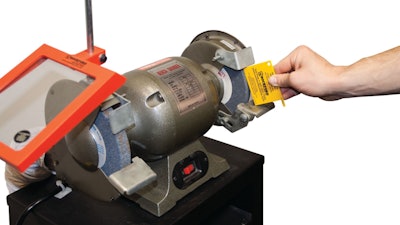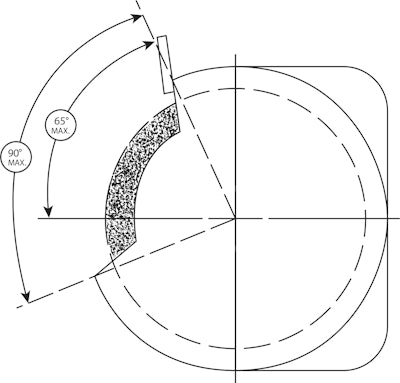
Because bench grinders are everyday machinery in workplaces nationwide, many operators become complacent about their hazards. However, bench grinders are very dangerous when used improperly.
Statistics show that more than half of grinder injuries such as fingers caught in the machine or eye and face lacerations are the result of operator error. Rockford Systems, LLC, a provider of machine safeguarding products and services, offers this primer on grinder safety regulations to help prevent accidents.
It is important to be fully versed in the regulations that outline safe grinder installation, maintenance and operation. The workplace regulations that apply to grinders are OSHA 29 CFR SubPart O 1910.215, a "machine specific" (vertical) regulation with a number of requirements, which if left unchecked, are often cited by OSHA as violations.
ANSI B11.9-2010 (Grinders) and ANSI B7.1 2000 (Abrasive Wheels) also apply. Carefully review these sets of regulations before operating any grinding machinery.
Work-Rests and Tongue-Guards
OSHA specifies that work-rests be kept adjusted to within 1/8-inch of the wheel to prevent the workpiece from being jammed between the wheel and the rest, resulting in potential wheel breakage.
Because grinders run at such high RPM, wheels actually explode when they break, causing very serious injuries, blindness and even death. In addition, the distance between the grinding wheel and the adjustable tongue-guard - also known as a "spark arrestor" - must never exceed 1/4-inch. Because the wheel wears down during use, both these dimensions must be regularly checked and adjusted.
Grinder safety gauges can be used during the installation, maintenance and inspection of bench/pedestal grinders to ensure work-rests and tongue-guards comply with OSHA's 1910.215 regulation and ANSI standards.
To do so, wait until the wheel has completely stopped and the grinder is properly locked out before using a grinder safety gauge. Grinder coast-down time takes several minutes, which may tempt an impatient employee to use the gauge while the wheel is still rotating.
This practice is very dangerous because it can cause wheel breakage. Other advice: where grinders are concerned, personal protective equipment (PPE) usually means a full face-shield, not just safety glasses.
The fact is, an employee cannot be too careful with a machine that operates at several thousand RPM. Remember to document any safety requirements set forth by OSHA as that is the best evidence that safety procedures are being followed.
Ring-Testing
OSHA requires that grinding wheels be ring tested before mounting them. This simple step prevents the inadvertent mounting of a cracked grinding wheel.
Ring-Testing involves suspending the grinding wheel by its center hole, then tapping the side of the wheel with a non-metallic object. This should produce a bell tone if the wheel is intact. A thud or a cracked-plate sound indicates a cracked wheel.
For larger grinders, grinding wheels are laid flat on a vibration-table with sand evenly spread over the wheel. If the wheel is cracked, the sand moves away from the crack.
To prevent cracking a wheel during the mounting procedure, employees must be very carefully trained in those procedures. This starts with making sure the wheel is properly matched to that particular grinder, using proper blotters and spacers and knowing exactly how much pressure to exert with a torque-wrench, just to mention a few things.
Wheel Covers
This OSHA-compliant Wheel-Cover allows no more than a total of 90 degrees of the wheel left exposed. (65 degrees from horizontal plane to the top of wheel-cover).
Never exceed these wheel-cover maximum opening dimensions. Larger wheel-cover openings create a wider pattern of flying debris should the wheel explode.
A well-recognized safety precaution on bench/pedestal grinders is to stand well off to the side of the wheel for the first full minute before using the machine.
Accidents have shown that grinding wheels are most likely to shatter/explode during that first minute. OSHA Instruction Standard #STD 1-12.8 October 30, 1978 addresses the conditional and temporary removal of the "Work Rest" for use only with larger piece parts based on the condition that "Side Guards" are provided.
 OSHA allows no more than a total of 90 degrees of the wheel left exposed.Rockford Systems
OSHA allows no more than a total of 90 degrees of the wheel left exposed.Rockford Systems
Grinder Do's
- Always handle and store wheels in a careful manner
- Visually inspect all the wheels before mounting for possible damage
- Make sure operating speed of machine does not exceed speed marked on wheel, its blotter or container
- Check mounting flanges for equal size, relieved as required and correct diameter
- Use mounting blotters when supplied with wheels
- Be sure work rest is properly adjusted on bench pedestal and floor stand grinders
- Always use safety guard that covers a minimum of one-half the grinding wheel
- Allow newly mounted wheels to run at operating speed, with guard in place, for at least one minute before grinding
- Always wear safety glasses or some type of approved eye protection while grinding
- Turn off coolant before stopping wheel to avoid creating an out-of-balance condition
Grinder Don'ts
- Don't use a wheel that has been dropped or appears to have been abused
- Don't force a wheel onto a machine or alter the size of the mounting hole - if a wheel won't fit the machine, get one that will
- Don't ever exceed maximum operating speed established for the wheel
- Don't use mounting flanges on which the bearing surfaces are not clean, flat and smooth
- Don't tighten the mounting nut excessively
- Don't grind on the side of conventional, straight or Type 1 wheels
- Don't start the machine until the safety guard is properly and securely in place
- Don't jam work into the wheel
- Don't stand directly in front of a grinding wheel whenever a grinder is started
- Don't grind material for which the wheel is not designed























